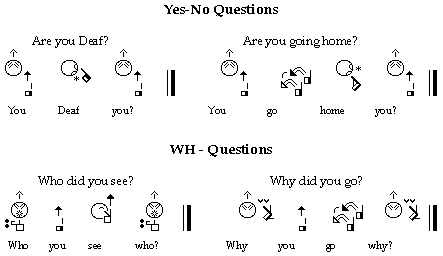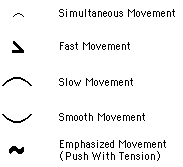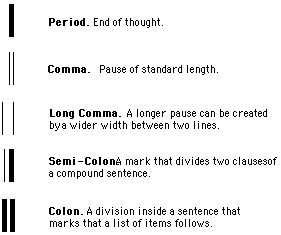|
Chapter 5, Part Two
continued...
In addition to handling the cheremes, or sign formational
aspects of ASL, SignWriting adds small bars to the inside
of the circle (face symbol) to indicate facial expressions. SignWriting
can include the necessary Yes/No-question raised eyebrow expression
, the furrowed brow and head tilt used for WH-questions and sentence
topic markers and it can indicate the nose when necessary.


SignWriting has symbols to indicate that the movement of two
hands is simultaneous, when it involves the right and left hand
moving in opposition, and when one hand stays still as the other
moves. It can even indicate when the movement in a sign should
be signed smoothly, slowly, quickly, tense or relaxed...*Footnote 14...

*Footnote 14: SignWriting symbols may
indicate a sign is signed slowly , quickly ,tense ,or relaxed.


Any word written in SignWriting has the face, or shoulder
bar on top (if necessary) and the handshape(s) around the face
or shoulder bar. General movements are below the handshape(s)
, but finger movements are indicated by the fingers of the handshape(s)
and head movements are indicated by the face symbol . A sign
dictionary written in SignWriting looks up lexical items based
on the ten groups of handshapes, then on the movements, also
broken down into groups, then facial expressions, then head and
body positions as demonstrated in Appendix G.
Two questionable SignWriting practices involve punctuation and
the writing of fingerspelled words. Punctuation in SignWriting
makes use of bars. One vertical, slightly thick bar placed after
a sign indicates a period. Two thin vertical bars indicate a
pause or comma , and two thin vertical bars slightly further
apart indicate a longer pause or semi-colon . Two bars next to
each other, one thin and the other thick indicate a question
mark . Two thick bars indicate a colon . Parentheses and quotes
look similar to the punctuation marks used in English. All of
the punctuation marks used in SignWriting can be the same as
those used to write English: . , ; ? : ( ).

There is no reason for SignWriting to adopt unique punctuation
marks for American Sign Language and it does not take away from
the writing of SignWriting to use English punctuation marks.
Furthermore, when a signer fingerspells an English word in ASL,
SignWriting uses the appropriate handshape symbol to write the
letters in the English word. This is also possibly a convention
that could be changed. Writing SignWriting by hand, one would
probably write the fingerspelled word in English letters instead
of writing the handshapes for each of the letters...*Footnote
15...

*Footnote 15:
The fingerspelled word "Ann" would be written in SignWriting:

It could be written ANN.

Other Writing Systems
The most widely used method for writing ASL is using English
words in ASL word order. This is unsuccessful because there is
no word-to-word correspondence between sign and English. ASL
verbs, for example, are inflected in ways that cannot be described
in a single English lexical item. Some have proposed the use
of Chinese characters to write ASL, but it is unlikely that Americans
will adopt the practice of spending copious amounts of time to
learn hundreds of characters with which they might then write
ASL when simpler methods are available. Most recently, methods
have been developed using the symbols found on any English keyboard
to write the phoneme-like pieces of each sign. This is similar
to and just as difficult to read as Stokoe notation, but easier
to type on a computer. The main reason SignWriting has a high
degree of potential for success is that it includes the signed
equivalent of phonemic information, while presenting what
looks like a kind of ideograph.
Chapter 5 examined American Sign Language as a three-dimensional
system being encoded on paper through writing. It presented the
difference between writing ASL in SignWriting versus a less iconic
system. Writing ASL in a linear fashion where the handshape,
movement, location and facial expression involved in creating
a sign would be placed in an arbitrary sequence like "I*~>>"
makes less sense than writing ASL in SignWriting:
 ("idea"). ("idea").
|



 ("idea").
("idea").